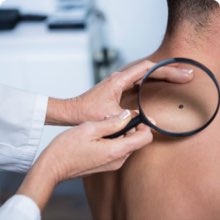A skin biopsy is a procedure in which a small sample of skin is removed for examination. The skin sample is examined under a microscope to detect skin cancer , skin infections or skin diseases such as psoriasis .
There are three main ways to do a skin biopsy:
- A punch biopsy, which uses a special circular tool to collect the sample
- An exfoliative biopsy, which takes the sample with a razor blade
- An excisional biopsy, which takes the sample with a small knife called a scalpel
The type of biopsy obtained depends on the location and size of the abnormal part of the skin, known as a skin lesion. Most skin biopsies can be done in a doctor’s office or and do not require a hospital stay.
Other names: punch biopsy, shave biopsy, excisional biopsy, skin cancer biopsy, basal cell biopsy, squamous cell biopsy, melanoma biopsy
For what do you use it?
A skin biopsy is used to diagnose a variety of skin conditions, including:
- Skin conditions, such as psoriasis and eczema
- Bacterial or fungal infections of the skin
- Skin cancer. A biopsy can confirm whether or not a mole or other suspicious growth is cancerous.
Skin cancer is the most common type of cancer in the United States. The most common types of skin cancer are basal cell and squamous cell. These cancers rarely spread to other parts of the body and are usually curable with treatment. A third type of skin cancer is called melanoma. Melanoma is less common than the other two, but it is more dangerous because it is more likely to spread. Most skin cancer deaths are caused by melanoma.
A skin biopsy can diagnose skin cancer in the early stages, when it is easiest to treat.
Why do I need a skin biopsy?
You may need a skin biopsy if you have certain symptoms, for example:
- A persistent rash
- Scaly or rough skin
- Open wounds
- A mole or other growth that is irregular in shape, color, or size
What happens during a skin biopsy?
A doctor cleans the biopsy site and injects you with an anesthetic so you don’t feel pain during the procedure. The rest of the steps in the procedure depend on the type of skin biopsy. There are three main types:
Punch biopsy
- The doctor places a special circular tool on the abnormal skin (lesion) and rotates it to remove a sample of skin (about the size of a pencil eraser).
- The sample removed with a special tool
- If a larger sample is taken, they may need one or two stitches to cover the biopsy site
- Pressure applied to the region until the bleeding stops
- The site covered with a sterile dressing or bandage
Punch biopsy often used to diagnose rashes.
Exfoliative biopsy
- The doctor uses a razor blade or scalpel to take a sample of the top layer of the skin.
- Pressure will applied to the biopsy region to stop the bleeding. You may also receive a medicine that placed on the skin (also called a topical medicine) to help stop the bleeding.
An exfoliative biopsy usually used if your doctor thinks you may have skin cancer, or if you have a rash that limited to the top layer of the skin.
Excisional biopsy
- The surgeon uses a scalpel to remove the entire skin lesion (the abnormal part of the skin)
- The surgeon closes the biopsy with stitches
- Pressure applied to the region until bleeding stops
- The site covered with a sterile dressing or bandage
An excisional biopsy often used if your doctor thinks you might have melanoma, the most serious type of skin cancer.
After the biopsy, keep the area covered with a bandage until it has healed or until the stitches come out. If you have stitches, they will removed 3 to 14 days after the procedure.
Is there anything I need to do to prepare for the test?
The skin biopsy does not require any special preparations.
Is this test at risk?
You may have a small bruise or some bleeding or pain at the biopsy site. If these symptoms last more than a few days or get worse, talk to your doctor or healthcare professional.
What do the results mean?
If your results normal, that means no cancer or skin disease found. If the results not normal, you may diagnosed with one of the following conditions:
- A bacterial or fungal infection
- A skin disease such as psoriasis
- Skin cancer. Results may indicate one of three types of skin cancer: basal cell, squamous cell, or melanoma
Learn more about medical tests, reference ranges, and how to understand the results .
Is there anything else I need to know about skin biopsy?
If you diagnosed with basal cell or squamous cell cancer. The entire cancerous lesion may removed at the time of the skin biopsy or shortly thereafter. Often, no other treatment needed. If melanoma diagnosed, more tests needed to see if the cancer has spread.
